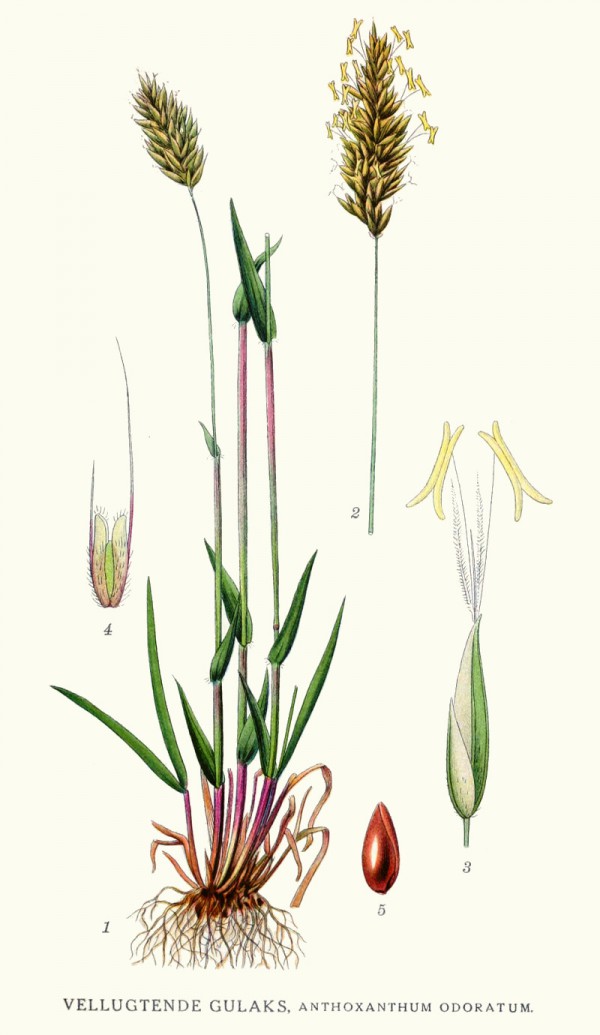Anthoxanthum odoratum L. - Poaceae - sweet vernalgrass, scented vernal grass, flouve odorante (fr.), Gewöhnliches Ruchgras
Perennial grass, up to 60cm high, native to Europe, West Asia, naturalized in Africa; leaves flat, up to 12cm long, glabrous or loosely pilose, smooth or scabrid, apex acuminate; panicle dense, spikelike, lanceolate; glumes unequal, pubescent or punctiform-scabrid, margins sometimes ciliate, lower glume ca. 1/2 length of upper glume; lower florets sterile, composed only of lemmas, first lemma awned from near middle; second lemma awned near base, awn geniculate; bisexual floret 2-3 mm, smooth, shiny, palea 1-veined; anthers 3-4.5mm.
http://www.efloras.org/florataxon.aspx?flora_id=2&taxon_id=200024834
The perfumery ingredient 'Flouve absolute' (with herbal coumarin scent, CAS 89957-44-8) is obtained by extraction from A.odoratum.
„Flouve absolute is a viscous, greenish-amber to brownish-yellow liquid, having a very sweet, herbaceous, tobacco-like and coumarinic odor. The odor is so rich and so complex that one can keep on finding notes in it. However, the overall fragrance is sweet, licorice-like, root-like, somewhat mossy-herbaceous like wet underforest and meadows, of exceptional tenacity and high penetrating power. [Arctander, Steffen. Perfume and flavor materials of natural origin. 1960, 185; reprint Arctander, Steffen. Perfume and flavor materials of natural origin. Lulu. com, 2017, 158-162 (orig.250-253)]
The major volatile component (steam distillation) of the oil from fresh leaves (96.3%) and hay (46.8%) was coumarin. A.odoratum hay oil also contained alcohols like amyl alcohol (0.1%), (Z)-3-hexenol (0.1%), heptanol (0.1%), octanol (3%), (Z)-2-octenol (0.1%), and borneol (0.1%); (Z)-3-hexenyl acetate (0.1%); furthermore 4-vinylguaiacol (1.9%) and its methyl ether (0.3%); aldehydes like valeraldehyde (0.6%), hexanal (0.3%), octanal (0.1%), nonanal (0.3%), (E)-2-decenal (0.1%), benzaldehyde (0.1%), phenylacetaldehyde (0.1%), and veratraldehyde (0.2%). The hay oil was treated with diazomethane, so acids could be quantified as their methyl esters like methyl butyrate (0.7%), methyl valerate (0.3%), methyl hexanoate (0.6%), methyl octanoate (0.9%), methyl nonanoate (1.0%), methyl decanoate (0.3%), methyl dodecanoate (1.3%), methyl tetradecanoate (1.3%), methyl hexadecanoate (9.9%), methyl linolenate (3%) e.g.
[Coumarin-containing grass: volatiles from sweet vernalgrass (Anthoxanthum odoratum L.)., Tava, A., Journal of Essential Oil Research, Vol.13(5), 2001, 367-370]
Coumarin showed also the major GC peak area in 14.7% of all investigated hay samples form the Alps (multi-species products), occuring together in every sample with phenylethanol, 6-methyl-5-hepten-2-one, p-cymene, Δ3-carene, linalool, β-ionone, and γ-muurolene.
[Valtiner, S. M., G. K. Bonn, and C. W. Huck. „Characterisation of different types of hay by solid‐phase micro‐extraction–gas chromatography mass spectrometry and multivariate data analysis.“ Phytochemical analysis 19.4 (2008): 359-367]

Lindman, C.A.M., Bilder ur Nordens Flora, vol.3, t.474 (1922-1926)
http://plantgenera.org/species.php?id_species=70013
Anthoxanthum odoratum © Rolf Marschner (2007),
www.botanische-spaziergaenge.at
see also: http://www.guenther-blaich.de/pflseite.php?par=Anthoxanthum+odoratum
